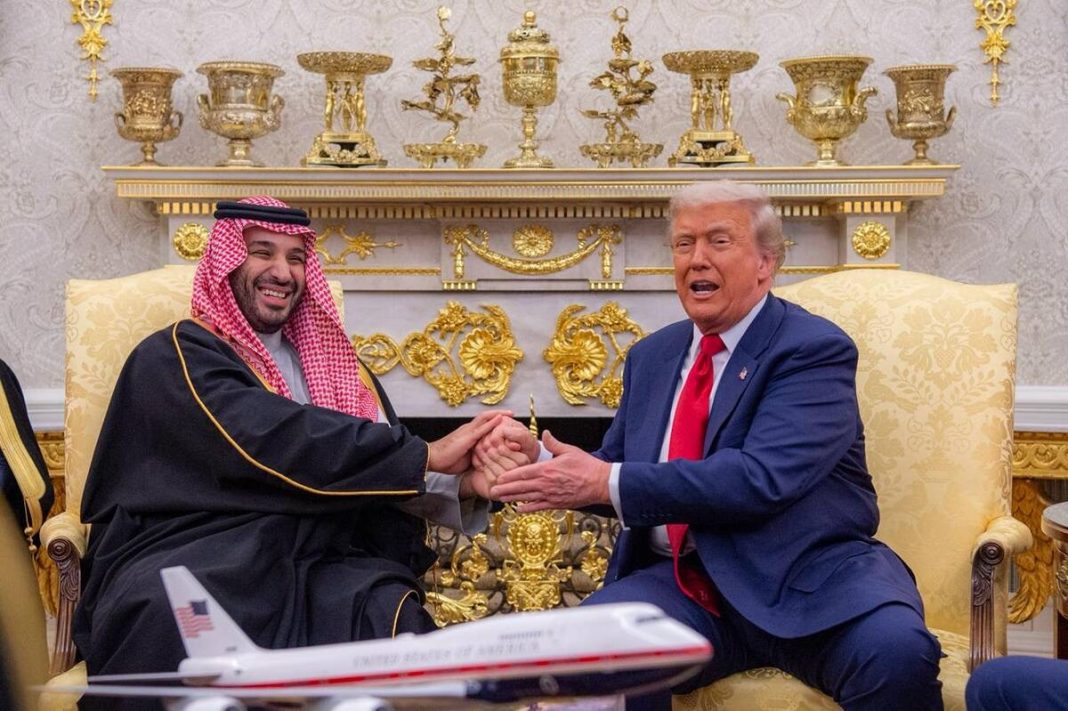Gabriel G Tabarani
The arrival of Crown Prince Mohammed bin Salman in Washington this week signals a dramatic reset in U.S.–Saudi relations, one driven by shared strategic interests but laden with deep moral and geopolitical tensions. At its surface the visit is marked by grand gestures—a promise of massive Saudi investment in the U.S., a potential sale of F-35 fighter jets to Riyadh, and the formal elevation of Saudi Arabia to “major non-NATO ally” status. Beneath the pomp, however, lies a calculation by both capitals: Washington seeking to anchor a key Gulf player more firmly to its orbit, and Riyadh aiming to transform its global standing while securing advanced military guarantees and economic integration with the West.
For the U.S., the attraction is clear. A robust partnership with Saudi Arabia promises access to significant capital, energy security, and enhanced cooperation on emerging technologies such as artificial intelligence and critical minerals. By tying Riyadh closer to American industry and supply chains, Washington reinforces its global competitiveness while simultaneously bolstering its strategic position in the Middle East. Saudi Arabia, for its part, sees this visit as an affirmation of its leadership ambitions and as a vehicle to propel its Vision 2030 agenda of diversifying its economy away from oil dependency and modernizing its society.
Yet this rapprochement raises profound questions. The normalization of relations comes despite Saudi Arabia’s record on human rights and the unresolved global scandal of the 2018 killing of journalist Jamal Khashoggi, a case in which U.S. intelligence found the crown prince likely complicit. That fact seems largely forgotten in this new posture of cooperation—a matter of concern for those who warn that strategic convenience is once again trumping principle. Moreover, the potential sale of elite military hardware to Riyadh—previously reserved for Israel—has ignited alarm across the region about shifting power balances and the erosion of safeguards that once underpinned U.S. alliances.
The trilateral calculus of deterrence, investment and technology is seductive, but the political risks are real. A security pact of this depth effectively binds the U.S. to protect the Saudi regime, even as the internal politics of the kingdom remain highly centralized, opaque and unaccountable. Should Tehran or Yemen’s Houthis strike at Riyadh, American forces may find themselves drawn into a conflict without bipartisan consensus or clear national interest. Meanwhile, linking tech and defence exports to Riyadh’s strategic goals may compromise U.S. leverage to press for reform and accountability.
From Riyadh’s perspective, the timing of this visit is deliberate. The crown prince has spent recent years reshaping his international image—repairing ties with Iran, recalibrating Saudi policy toward Yemen, and extending a hand to Syria. By walking into the Oval Office and being treated as a peer, he reclaims the global status that was jeopardised after Khashoggi’s murder. He moves from being a regional disruptor to a broker of stability, at least in rhetoric, and asks Washington to endorse that transformation—along with the billions of dollars that follow.
However, the transformational promise remains contingent. Saudi pledges of unprecedented U.S. investment must turn into tangible commitments; promised reforms in Riyadh’s economy and society must materialise beyond spectacle. For Washington, the triumph will only be real if these deals yield jobs, innovation and long-term strategic value—not just a headline aura of rapprochement. For Saudi Arabia, the legitimacy of this new partnership will rest on whether modernization becomes inclusive, whether dissent is tolerated, and whether the kingdom begins to live up to its stated aspirations.
This visit should thus be viewed as both opportunity and inflection point. It opens a window for the United States to reshape Gulf architecture around 21st-century imperatives—tech, capital and defence integration—rather than retrograde oil and arms deals. It affords Saudi Arabia a chance to transcend its past and anchor itself on a broader platform of global engagement. But neither capital should kid itself: the underlying tensions remain. The legacies of Yemen, the unresolved Khashoggi case, the risk of a runaway arms spiral, and the moral questions about backing autocratic power all hang over this moment.
If the partnership is to succeed it must move beyond ceremonial accords and mutual photo-ops. It must deliver measurable outcomes for ordinary citizens on both sides of the deal: American workers, Saudi youth, regional neighbours, and dissenting voices alike. The gravity of the commitments on the table demands more than transactional posture—it demands accountability, sustainability and a genuine strategic horizon.
Ultimately, this week’s visit may be remembered as the moment the U.S. and Saudi Arabia decided to turn a page—but whether that page is the beginning of a new chapter of effective partnership, or a reprise of old transactional tropes, depends on the hard work that follows. In the face of evolving global dynamics, both capitals must ask: are we building a durable alliance fit for the next half-century, or merely trading the optics of friendship for the convenience of today?
This article was originally published in Arabic on the Asswak Al-Arab website

